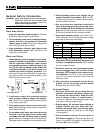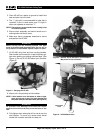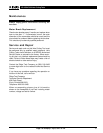
Ridge Tool Company • Elyria, Ohio • U.S.A.
9
Specifications
Cutting Capacity............Up to 3″ (76mm)
Pipe Mounting
Capacity ........................1
1
/
4
″ - 8″ (30mm-200mm)
Drill Chuck Capacity......
1
/
16
″ -
1
/
2
″ (2mm-13mm)
Drill Chuck Speed..........360 RPM
Motor Horsepower.........1.2 HP
Current Draw Rating......11 Amps @ 115V
Dimensions
Height............................12.8″ (32.5 cm)
Length ...........................11.9″ (30.2 cm)
Width .............................13.2″ (33.4 cm)
Total Weight ..................31 lbs. (14 kg)
Base ...........................10 lbs. (4.5 kg)
Motor Assy. ................21 lbs. (9.5 kg)
Standard Equipment
• Hole Cutting Tool (Base and Motor Assembly)
• Chuck Key
Accessories
• Hole Saws Arbors
• Hole Saws
• Carrying Case
Inspect Hole Cutting Tool
WARNING
To prevent serious injury, inspect your Hole
Cutting Tool on a regular basis. The following
inspection procedures should be performed
before each use of the tool:
1. Inspect the power cord and plug for damage. If the
grounding prong is missing or the cord or GFCI is
damaged, do not use the tool until the cord has
been replaced.
2. Make sure the switches turn the tool ON and OFF.
If broken, do not use until they are replaced.
3. Inspect the hole cutting tool for any broken, miss-
ing, misaligned, or binding parts as well as any
conditions, which may affect the safe and normal
operation of the tool. If any of these conditions are
present, do not use the tool until the problem has
been repaired. Do not use dull, bent, or damaged
hole saws or arbors.
4. Test the Ground Fault Circuit Interrupter (GFCI) to
insure it is operating correctly. When test button is
pushed in, the indicator light should go OFF.
Reactivate by pushing the reset button in. If the
indicator light goes ON, the tool is ready to use. If
broken, do not use the tool until it is replaced.
5. Clean any oil, grease, or dirt from the handles.
This reduces the risk of injury due to the tool slip-
ping from your grip.
6. Use only accessories recommended for your tool.
Accessories used for other tools may be hazardous
when used on a hole saw and lead to serious
injury.
7. Inspect the cutting edges of your hole saws. If nec-
essary, replace prior to using in your hole-cutting
tool. Dull or damaged cutting edges can lead to
injury, tool breakage, or excessive heat buildup in
the workpiece and the tool.
Set-Up Instructions
Model HC-300
WARNING
When setting up the hole saw, it should be
unplugged and the switch should be in the OFF
position. To prevent serious injury, the tool must
be properly set up.
1. Determine the size and location of the hole to be
cut. Follow coupling manufacturer’s recommenda-
tions for hole size to coupling size.
2. Select hole saw and arbor to the hole size required.
See section 5 of the RIDGID catalog for saw order-
ing information.
3. Place the HC-300 on a clean bench or ground to
install hole saw and arbor into drill chuck.
NOTE! The
1
/
4
″ pilot drill is recommended for pipe that is
installed for it prevents the pipe slug from falling
into the system. If pilot is used, make sure it is
tight in arbor and exposed no more than
3
/
8
″.
4. Ensure the chain assembly and sliding bar handle
is in working order and free to move.
NOTE! It is possible to attach the HC-300 to the pipe as a
complete assembly or in two pieces.
HC-450/HC-300 Hole Cutting Tools


















